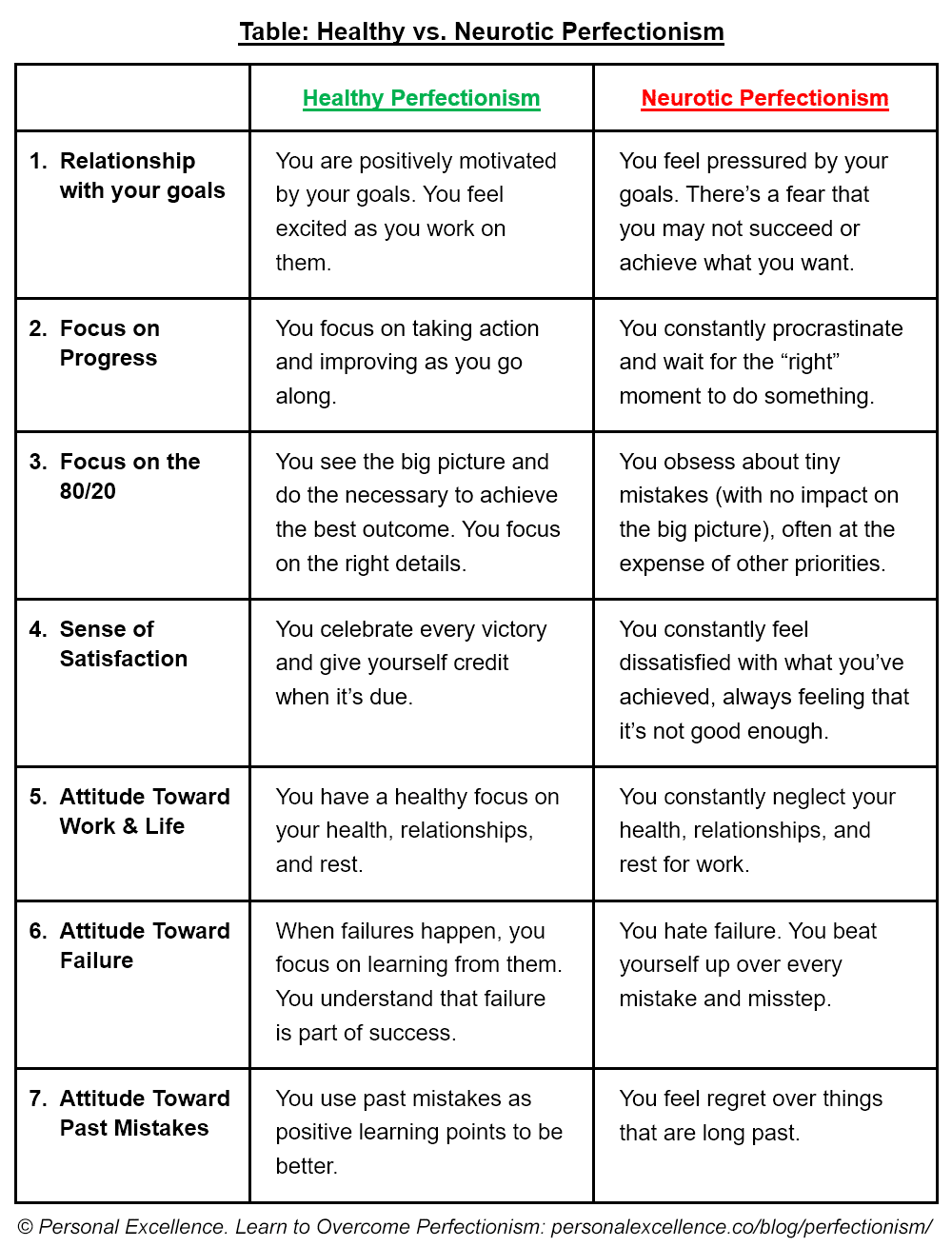
This is the last part of my 3-part series on perfectionism: why being a perfectionist has its problems, the downsides of perfectionism, and how to overcome these downsides.
- Part 1: 10 Signs You Are a Perfectionist
- Part 2: 6 Negative Effects of Perfectionism
- Part 3: How To Overcome Perfectionism: Your Complete Guide
So far, I’ve shared the 11 signs of perfectionism. I’ve also shared 6 hidden downsides of perfectionism, including procrastination, having a skewed view of reality, experiencing deep inner unhappiness, compromising your health, and compromising your relationships.
As a neurotic perfectionist, I have experienced the debilitating effects of perfectionism. Instead of helping you be a better person, perfectionism can turn into a compulsive disorder, in turn ruining your life and your soul.
If you are struggling with perfectionism, I’ve created this guide to help you. I share the 8 important steps I took to deal with my perfectionism and to help my clients work through theirs. At 3,300 words long, it’s not meant to be read in one go but to be read and implemented over time. Be sure to bookmark and share it with your friends and family. Enjoy! :)
1. Be a healthy perfectionist, not a neurotic one

Perfectionism can be a healthy trait. The problem comes when it’s taken to the extreme.
Many of the issues I shared in parts 1 and 2 are the result of neurotic perfectionism, which is the extreme, maladaptive form of perfectionism. Neurotic perfectionists let their achievements define who they are and often experience deep unhappiness over their goals. They aim for high standards at the expense of everything, from their relationships to their health. Unfortunately, this is also the kind of perfectionism glorified in media, where an unhealthy attachment to things and a neurotic focus on results are made to seem like they are normal.
On the other hand, there is healthy perfectionism. Unlike neurotic perfectionists, healthy perfectionists are positively motivated by high standards and use that to spur them forward. They are committed to their goals but do not let failures weigh them down nor define them.
By learning the difference between these 2 types of perfectionism, you can learn to recognize when you’re bordering into the “neurotic” zone and moderate your behavior accordingly. I’ve created a list of differentiating behaviors between healthy and neurotic perfectionism, broken into 7 categories (click the image below for larger version):
Make a printout of this table and use it as a self-checking tool to keep your perfectionistic tendencies in check. Use the behaviors under “Healthy Perfectionism” as your benchmark. Through practice, you can become more balanced in your approach! :)
2. Remove the all-or-nothing mindset

The “all-or-nothing” mindset is a big problem among perfectionists in general. Perfectionists tend to think in terms of very strict dichotomies. For example, “Black” or “White.” “All” or “Nothing.” “Success” or “Failure.” “Complete everything” or “Don’t do it at all.”
Yet, such thinking is self-defeating and at best, unreal. In the real world, no one achieves success smoothly without failure. No athlete wins a tournament without struggling with their training. No entrepreneur succeeds without having failed in some form or manner first. And no one produces great work without first struggling with their tools and producing some kind of lousy work. In reality, everything happens in progression, not in an all-or-nothing manner.
Silicon Valley, home to thousands of tech companies including top corporations like Facebook, Apple, and Google, is known to strongly encourage failure. Entrepreneurs are often giving talks sharing about their own failures. People there live by the mantra “Fail fast, fail often.” They even have a annual conference called FailCon to encourage people to embrace failure. That’s because they recognize that failure is the path of success, and by failing quickly, it is the surest way to learn what works / doesn’t work and grow.
Hence, get rid of that all-or-nothing mindset. When you think all-or-nothing, what you really get is nothing-and-nothing. Allow yourself to do things incompletely, imperfectly, and imprecisely. That’s how you can then progress to the state of completion and precision. Focus on maximizing progress every step of the way, including through experimentation and failure, as that is the surest way to guarantee your fastest success.
3. Avoid the perfectionist’s mind trap (aka Go for the 80/20)
The perfectionist’s mind is an elaborate labyrinth. It’s capable of absorbing large amounts of information, analyzing details, and setting elaborate requisites for every task.
Yet, you need to be careful of the perfectionist’s mind trap, a term I use to refer to a perfectionist’s ability to trap themselves with an endless focus on unimportant information and requisites. Because a perfectionist is detail-oriented and capable of absorbing high levels of information, they are also their weakest link when it comes to taking action. To them, everything is important and everything must be done. In the end, they get overwhelmed. Some perfectionists procrastinate; some get stuck in analysis paralysis mode. Some give up, while some spend an excruciating amount of time just to get simple things done.

Are you suffering from the perfectionist’s mind trap?
For example, a neurotic trainer may feel that he needs to color-code his slides and get premium folders with embossed logos for his trainees’ handouts, but maybe what his trainees really care about is his content and whether he can help them solve their problems. The extreme dieter may feel that she needs to fast repeatedly every time she falls off the wagon to succeed in her weight loss, but maybe it’s more important that she eats healthily and eats within her energy needs more often than not.
I shared my mind trap in part 2 regarding audio editing, where I used to worry over the removal of every little “click,” slight pause, saliva sound, and so on in my podcast episodes. Yet, listening to other podcasts, and top-rated ones at that, made me realize that having such sounds is entirely okay as long as they are not in excess. They make the listening experience more personal. Perfect removal of these things wouldn’t dramatically change the utility of my material as much as giving my best quality tips will.
To you, perhaps you have an extremely high standard for every piece of work you create. However, you may struggle with this high standard very often, to the point that it drains you from getting more done. If so, I have these questions for you:
- What are you trying to achieve here?
- Who are people who have achieved this goal or are doing it extremely well now? What did they do to succeed?
- Taking into account your answers to Q2, the details you have been obsessed about — are these essential to the success of your goal? If not, is it time to set them aside (or to reduce your focus on them)? Focus on the 80/20, the crucial few factors that bring the most impact to your goal. Beware of diminishing returns that come from trying to push and perfect every little thing, especially factors that ultimately do not affect what you’re trying to achieve.
Read:
- The 80/20 Rule (3-part series)
- The Law of Diminishing Returns
4. Learn to respect and love yourself

As a perfectionist, I can understand the negative self-talk and self-neglect that happens, especially when the going gets tough. It’s easy to berate yourself when things don’t go to plan. It’s easy to sacrifice your well-being because you prize your work. It’s also easy to blame yourself for others’ issues, mistakes.
However, this usually happens because you’re not putting yourself at a high enough regard. For me, I say things like “I hate myself” or “I’m a lousy person” when I’m not happy with how things are going. But that’s because I allow my goals and others’ issues to take precedence over my self-identity and self-love. I sacrifice my own sleep and rest in order to complete my work and meet deadlines. But that’s because I’m not putting my health at a high regard, relative to my mission.
Does it mean that we should discard everyone’s needs and only value ourselves? No, of course not. What I’m saying is that we need to learn to respect ourselves and our needs, while valuing others’ needs. We need to learn to love ourselves and our flaws, just as we love others without precondition. And we should certainly continue to dedicate ourselves to our craft, but without compromising our well-being.
Here are some directives for you:
- Switch your negative self-talk. The next time you berate yourself, switch to positive self-talk. Instead of “I hate myself,” switch to, “I treasure myself.” Instead of “I’m a lousy person,” switch to, “I’m a good human being who is trying his/her best.” Instead of “I’m not good enough,” switch to, “I have my own unique talents and I’m improving every second.”
- Stop self-blame. I know it’s easy to beat yourself up when things don’t go your way. But recognize that you have done your best. You did what you could within the circumstance. Instead of blaming yourself, give yourself credit for what you’ve been doing. Love and appreciate yourself.
- Think of 3 things you are doing right. A neurotic perfectionist tends to focus on lack and the things that they aren’t doing well. Turn that around by focusing on the things you are doing well. What are 3 things you have done right, in this goal, or in your life? Focus on them and repeat this question whenever you have negative self-talk. When done often, you’ll begin to recognize your own strengths naturally.
- Make health a priority. No one can stop you from sacrificing rest in the name of work, but you got to ask yourself if this is what you want for the next 40 years. Our health is the cumulative result of how we’ve cared for our body through our life, not what we did in the past month. This means that constant lack of rest and self-care today will put your health in a severe state of decline 10, 20 years from now. Is this what you want? How about you start your self-care now?
For those of you with Be a Better Me in 30 Days, check out Day 16’s task on Appreciate Yourself.
5. Use your ideals as guides, not absolutes
Perfectionists tend to get very attached to their goals. Didn’t achieve a particular target? That means I’ve failed, they think. Didn’t accomplish a goal in a certain time frame? That means I’m worthless ****, they think. They take their goals as a representation of their worth and beat themselves up when things don’t go their way. Some decide that their goals aren’t for them and write off goal setting altogether; some fall into depression.
But is that true? That when you don’t achieve your goals (in a ready fashion), that you are lousy and worthless? No, of course not. Just because you don’t achieve your goals in a particular time frame doesn’t mean you have failed — it just means that you didn’t achieve your targets in that particular time frame. Perhaps there were things that cropped up. Perhaps your approach was wrong. Perhaps the goal you’re going for isn’t compatible and you need to set a more compatible goal.
Realize that your goals are meant as guides, not absolutes. “Guide” meaning that your goal is intended to guide you in your path of betterment. “Not an absolute” meaning your goal isn’t some hard, unbendable target, where not achieving it means that you are a deficient person (which is rubbish by the way). You are more than your goals and achievements. You are here to make a huge dent in the universe.
What this means is, continue to set big goals. Let your heart run wild with your biggest goals and dreams, and let them guide you. Whether you’ve achieved a particular goal yet is not as important as the fact that you’re progressing towards it.
Remember, your real goal in life is to grow and work on being your best self. Your goals are simply guides to help you do so.
More here:
- What is the Message of Your Goal?
- When Goals Stop Working
- How To Be The Most Confident Person In The World
6. Value your relationships

As I grow older, I’ve learned to value relationships more. I used to prioritize work over my personal life, which includes my relationships as well. I always thought that I should always put my 100% energy into work (leaving little space for myself and others), and a big part of this stemmed from growing up in a country where the national rhetoric prizes work and achievements over personal needs and leisure; where the people work the longest hours in the world (2,402 hours per year in Singapore, compared to 1,654–1,790 in the U.S., Britain, and Canada).
But this is a poor message in retrospect. It’s important to be dedicated to your craft, but life doesn’t revolve around just your work. You have your family. You have your relationships. You have the people you love. For some of you, your motivation (or part of your motivation) to do well at work is likely driven by your loved ones. According to Bronnie Ware, a palliative nurse, one of the top 5 regrets of the dying is “I wish I hadn’t worked so hard,” and this was a regret stated by all men she nursed (this was before females started to become breadwinners as well).
Allocate time for your relationships. Set aside some time for your loved ones each day. 30 minutes, an hour, 2 hours; whatever you can set aside for now. Show them care and concern. Give them a hug, a kiss, each time you see them. Ask them how they are doing and get involved in their days. Very importantly, remember to treat them as individuals, without prejudice or expectations that may surface from a perfectionist mind.
7. Celebrate every progress, victory, and failure

I find that perfectionists tend to focus on lack while having very harsh expectations of themselves. They never rest until they have finished what they are doing. They are rarely satisfied with what they do. They are always looking for mistakes, issues to correct. And they don’t celebrate much, even when they have done a good job — instead taking that as a given.
Lady Gaga, a perfectionist, once said that she’s perpetually unhappy with what she creates — something I mentioned in part 2. John Lennon from Beatles, one of the world’s most famous rock bands, mentioned in an interview that he is “dissatisfied with every record the Beatles ever [bleep]ing made.” He said, “There ain’t one of them I wouldn’t remake… including all the Beatles records and all my individual ones.” Michael Jackson once said, “I’m never pleased with anything, I’m a perfectionist, it’s part of who I am.” I myself am guilty of self-deprivation and self-blame while always expecting very high performance levels.
I suppose it’s one way to live, to feel constant dissatisfaction with your work and unhappiness with it. It helps you focus on pushing new grounds with your craft and improve on your gaps. However, may I suggest a different approach? Which is to celebrate everything you have done, including your progress, victories, mistakes and failures. That’s right — your mistakes and failures as well. This means if you’ve “only” made a 1% progress in your task, celebrate that. If you run into a roadblock, celebrate the discovery of this blind spot that you didn’t know of before. If you made some bad mistakes, acknowledge them, and then fix them accordingly. Be grateful for this experience to learn and improve. Needless to say, celebrate all your victories and give yourself a HUGE pat on the back for a job well done.
The interesting thing is that you may find that doing so doesn’t necessarily make you any lax with your work. If anything, it encourages you to strive for better. It acknowledges your strengths and abilities, and helps you harness them better. It also makes life a lot more fun, joyful, and enjoyable. Because as opposed to a constant focus on lack, you now acknowledge what you do have. And such an abundance mentality goes a long way in building a positive well-being, self-love, and emotional happiness.
Read: What I Learned From Growing Up in a Shaming Culture
For those of you with Live a Better Life in 30 Days, check out Day 13: Reflection Day and Day 14: A Day of Gratitude.
8. Delegate and Let Go
Finally, learn to delegate and let go.
As a perfectionist, you may find it tough to work with people. Being a superpower worker, you may feel that it’s easier and faster for you to do everything yourself, as opposed to relying on someone else. Not only that, you’re able to do everything in exactly the way you envision, vs. having to rely instructions to others and having to deal with errors and communication breakdowns in between.
However, I’ve found that it’s not possible to do everything alone, not especially if you wish to scale up your level of production and maintain the same high quality of work, not especially if you wish to excel in your work without neglecting your health and relationships. You can handle everything and work yourself to death, with no time for yourself and others. Is this what you want though?
You don’t have to do things alone. Find the right people who get you, train them, and iterate as you go along the way. While it’s hard to find the right people, that doesn’t mean that you give up, because there is great talent out there — you just need to separate the chaff from the wheat. Even if you are working with people whom you can’t choose — such as bosses and colleagues — it’s about learning to develop a rapport with them and finding a common way to work together.
This means
- Identify the areas you need assistance in.
- Get people to help you in these areas. It may be hiring staff or contractors if you run your own business, getting committed partners on board, engaging your co-workers/boss if you are working in a company, or even engaging a coach if it’s a new skill you wish to learn quickly.
- Share expectations and build a common understanding with them, so that there is no confusion.
- Know that gaps are normal. After years of working with people, I’ve learned that there is always a warm-up period when it comes to working with someone on a new task, and it’s normal. Just as it takes time for you to learn something new, it takes time for others to get things “right” the first time. Here, it’s about active communication as you work together to close the gap.
- Finally, allow yourself to let go. Not everyone will be able to do things exactly as you expect, and you shouldn’t expect that they do so, especially when it comes to creative, high-level work. Even if there are objective errors, give your co-workers/staff the guidance to learn from their errors (vs. correcting everything yourself), such that they know what to do next time. By letting go of very specific expectations and letting people do their thing — but within clear guidelines of course — you allow them to learn, grow, and subsequently deliver their best work to you. :)
Get the manifesto version of this article: How To Overcome Perfectionism [Manifesto]
This is the last part of my 3-part series on perfectionism: why being a perfectionist has its problems, the downsides of perfectionism, and how to overcome these downsides.
- Part 1: 10 Signs You Are a Perfectionist
- Part 2: 6 Negative Effects of Perfectionism
- Part 3: How To Overcome Perfectionism: Your Complete Guide
(Images: White flower, Healthy Perfectionism vs. Neurotic Perfectionism, Balance scale, Trap, Candles, Silhouette of a couple during sunrise, Victory)











 Thanks for reading. If you like my free articles, join my private email list and get my latest updates and articles sent right to your inbox.
Thanks for reading. If you like my free articles, join my private email list and get my latest updates and articles sent right to your inbox.